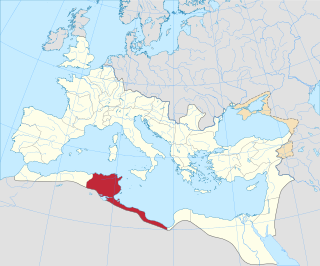
The Roman Catholic Diocese of Condom was a French bishopric based in Condom from 1317 to 1801.

Krbava is a historical region located in Mountainous Croatia and a former Catholic bishopric (1185–1460), precursor of the diocese of Modruš and present Latin titular see.
Berissa, also spelled Berisa, Verisa, or Verissa, was a city in the late Roman province of Pontus Polemoniacus, in Asia Minor, which Kiepert and W. M. Ramsay have identified with the modern village of Baulus, 25 kilometres south-west of Tokat.

Oschiri is a comune (municipality) and former bishopric in the Province of Sassari in the Italian region Sardinia, located about 170 kilometres (110 mi) north of Cagliari and about 40 kilometres (25 mi) southwest of Olbia.
Naissus was an ancient city and former bishopric in Balkanic Dacia, which remains a Latin Catholic titular see.

The Diocese of Guadix is a Latin suffragan diocese of the Catholic Church in the ecclesiastical province of Granada in Andalusia, southern Spain and a Latin titular bishopric under its Ancient name of Acci. Its cathedral episcopal see is Nuestra Señora de la Anunciación, dedicated to Our Lady of the Annunciation, in the city of Guadix, administrative province of Granada. It was commenced in 1710, on the site occupied by the principal mosque, and completed in 1796.
The Diocese of Castro di Sardegna was a Roman Catholic diocese located in the town of Oschiri in the Province of Sassari in the Italian region of Sardinia. In 1503, it was suppressed along with the Diocese of Bisarcio and the Diocese of Ottana to form the Diocese of Alghero.
The Diocese of Drivasto or Diocese of Drivast was a Roman Catholic bishopric with see in the town of Drivasto from circa 400 to 1650 and is now a Latin Catholic titular see. It was suppressed in 1650 but restored as Latin titular see.

Bulnensis also known as Bulna is a titular episcopal see of the Roman Catholic Church ascribed to the ecclesiastical province of Africa Proconsularis, as a suffragan of the Archdiocese of Carthage.
Bulnensis, also known as Bure, is a titular episcopal see of the Roman Catholic Church ascribed to the ecclesiastical province of Africa Proconsularis, as a suffragan of the Archdiocese of Carthage.
Taborenta, Mauretania Caesariensis was a Berber civitas (town) and bishopric in Roman North Africa. It disappeared during the 7th century, and is assumed to be near Saida in modern Algeria. It was nominally restored in 1933 as a titular see.
Buleliana was a civitas (town) and bishopric in Roman North Africa and remains a Latin Catholic titular see.
Drusiliana was a civitas (town) of Roman North Africa. Bingham called it a city of the Roman province of Mauretania Caesariensis. An inscription of Constantine the Great was found in the city ruins and it appears on the Tabula Peutingeriana The town has been tentatively identified with ruins near Khanguet-el-Kdim in northern Tunisia. Located at 36.249547°N 8.907667°E. Epigraphical evidence suggest Constantine the Great undertook some works in the city in 312AD.
Botriana is a locality and archaeological site in Tunisia

Uzzipari was a Roman town of the Roman Empire during late antiquity. An exact location for the town has been lost to history although that it was in the Roman province of Africa Proconsolaris means it must have been in northern Tunisia.

Zarna was a Roman town of the Roman Empire during late antiquity. An exact location for the town has been lost to history, although that it was in the Roman province of Africa Proconsolare means it must have been in northern Tunisia.
Dystis was a city and bishopric in Roman Libya, which remains a Latin Catholic titular see.

Culusi was a Roman town of the Roman province of Africa Proconsolare, located near Carthage. It is also known as Culcitana or Culsitana. The city is tentatively identified with ruins in the suburbs of Tunisia.
Henchir-Bladia is an archaeological site and locality in southern Tunisia. The stone ruins are tentatively associated with Bladia, a civitas of the Roman province of Byzacena during the Roman Empire. It was a Catholic bishopric.
Filaca was an ancient city in the Roman province of Africa Proconsularis and in late antiquity of Byzacena in what is today the Sahel region of Tunisia.










